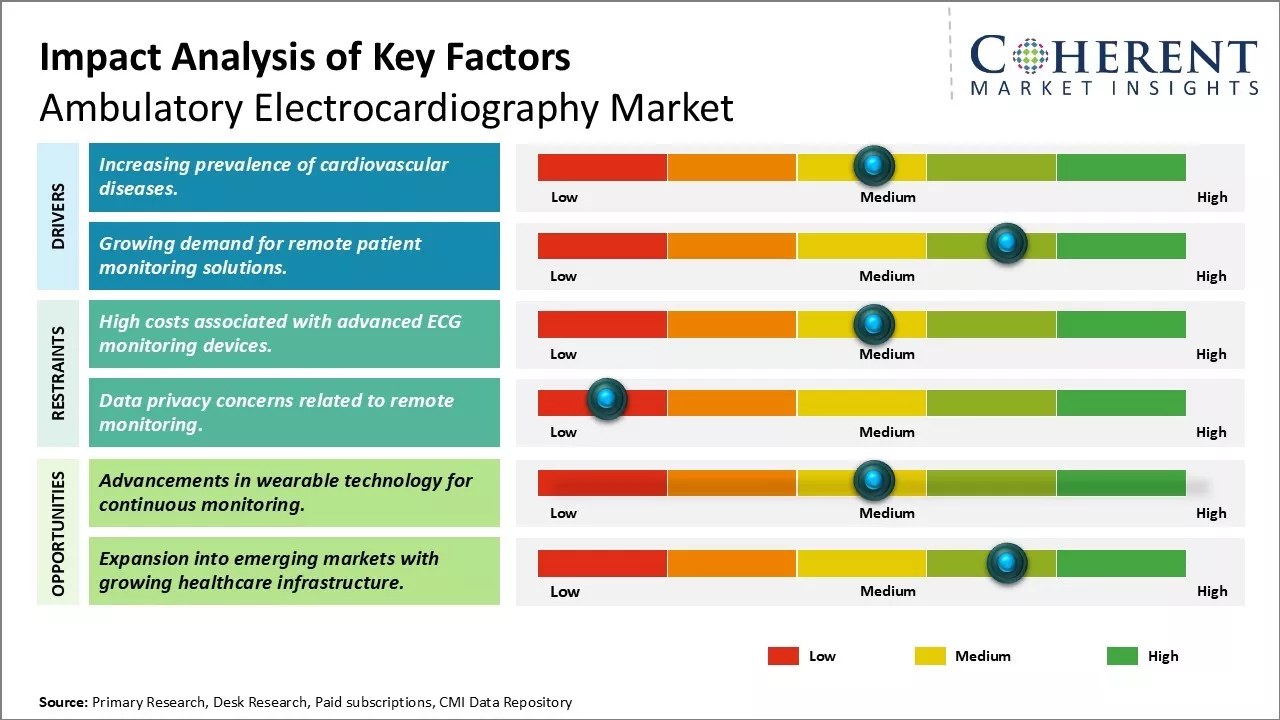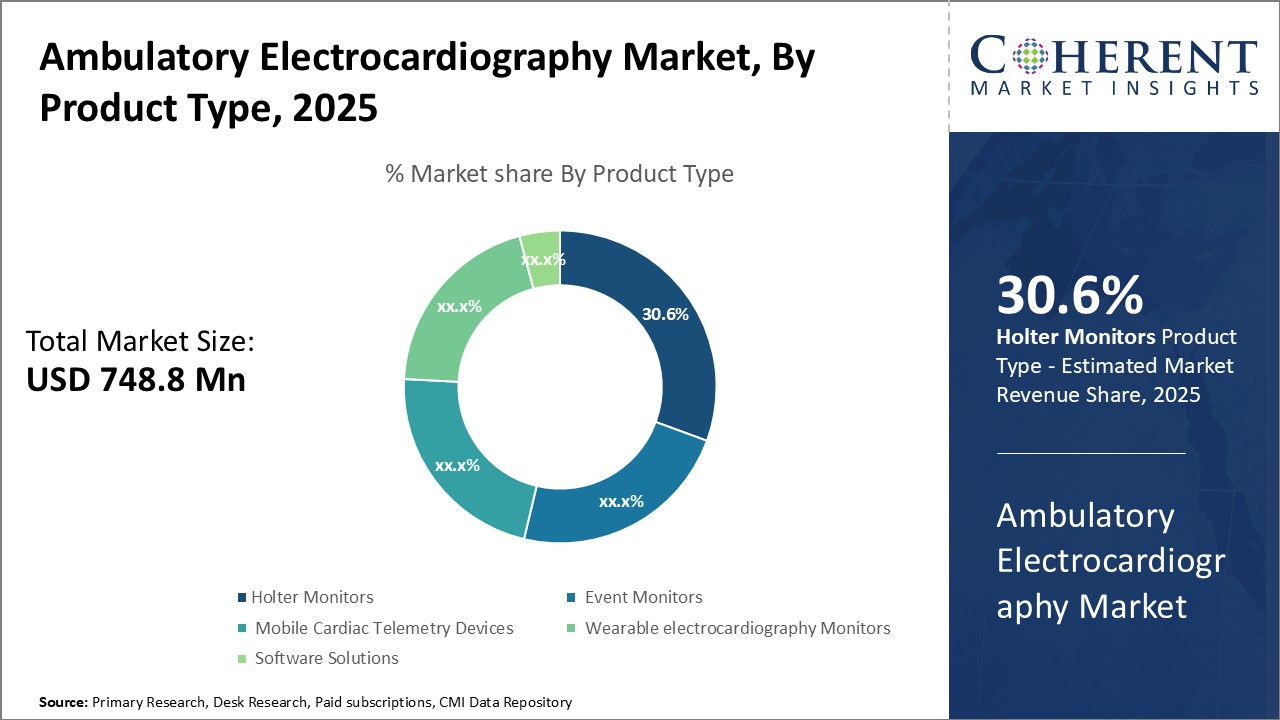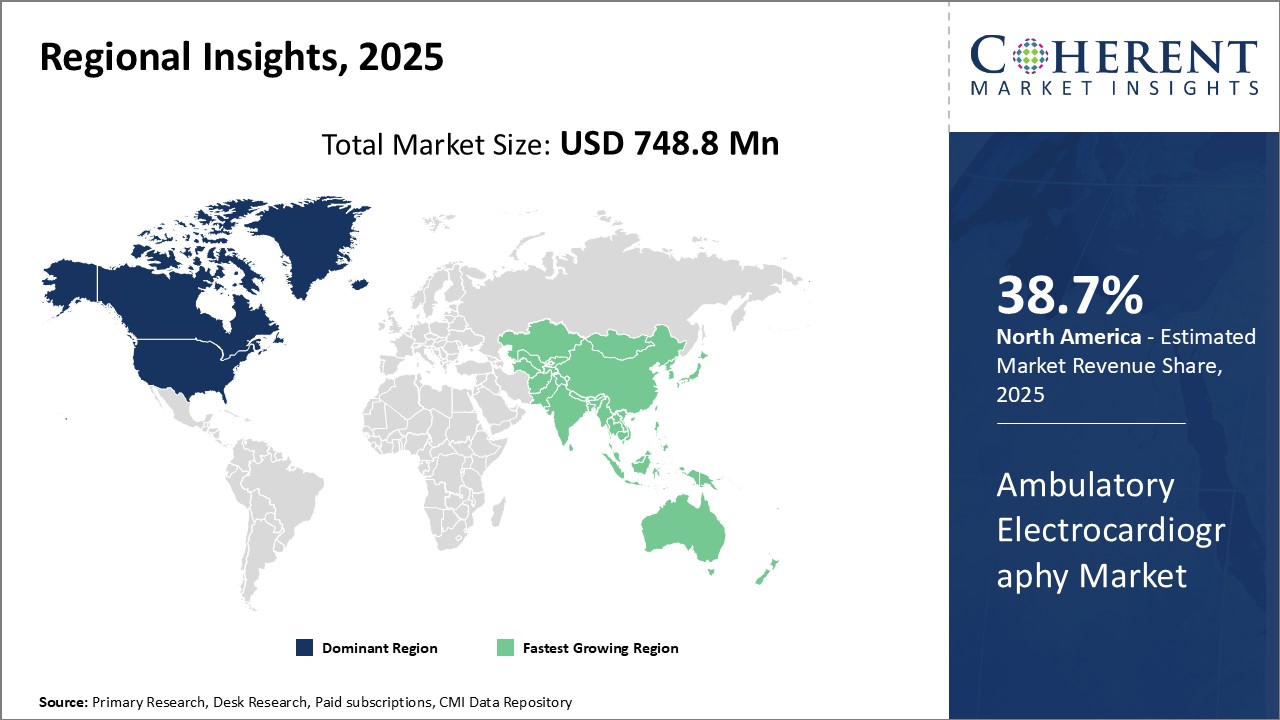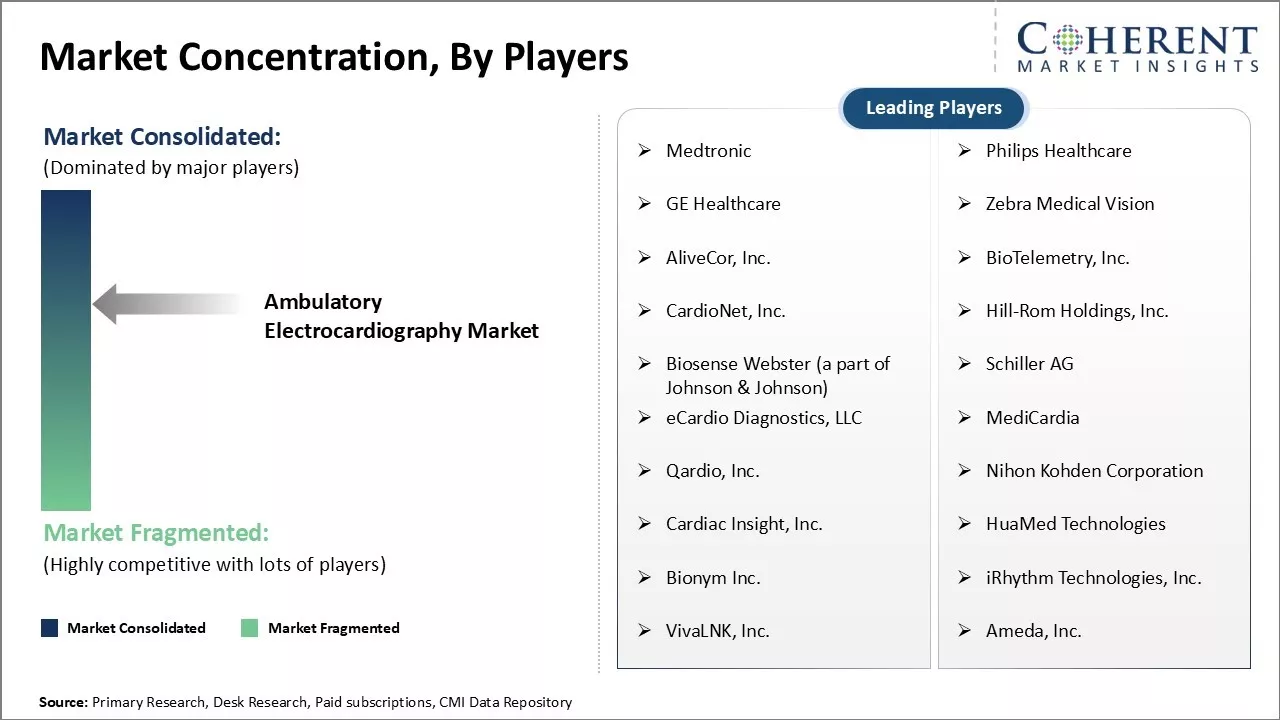Ambulatory Electrocardiography Market Size and Trends
The ambulatory electrocardiography market is estimated to be valued at USD 748.8 Mn in 2025 and is expected to reach USD 1,326.4 Mn by 2032, exhibiting a compound annual growth rate (CAGR) of 8.5% from 2025 to 2032.

Discover market dynamics shaping the industry: Download Free Sample
The global ambulatory electrocardiography market is expected to witness significant growth over the forecast period. This is largely attributed to the increasing prevalence of cardiovascular diseases worldwide coupled with growing geriatric population susceptible to arrhythmias and heart conditions. Additionally, advantages associated with ambulatory electrocardiography monitors over conventional Holter monitors such as ability to conduct daily life activities freely is further expected to support market expansion.

Discover high revenue pocket segments and roadmap to it: Download Free Sample
Insights By Product Type - The Convenience of Holter Monitors Drives their Market Dominance
Based on product type, Holter monitors segment is expected to lead the ambulatory electrocardiography market with 30.6% of the market share in 2025 due to their convenience and effectiveness. These portable devices enable continuous multi-channel electrocardiography recording for up to 30 days, capturing intermittent arrhythmias that may not appear during clinic visits. Their lightweight design allows patients to carry on with daily activities, enhancing acceptance and making them a preferred solution for long-term cardiac monitoring.
Insights By Application – Arrhythmias Detection Leads Owing to Its Critical Role in Irregular Heartbeat Detection
Based on application, arrhythmia detection segment is expected to hold the largest market share with 30.8% in 2025 due to its critical role in identifying irregular heartbeats, from minor to life-threatening. Ambulatory electrocardiography enables extended monitoring, increasing the chance of detecting intermittent arrhythmias often missed in short clinic visits. This application is essential for accurate diagnosis and treatment, making arrhythmia detection a core function and competitive focus for electrocardiography devices.
Insights By End User - Access and Convenience Drives Hospital Segment’s Dominance
Based on end user, hospitals lead the ambulatory electrocardiography market with share of 22.62% in 2025 due to their accessibility, infrastructure, and comprehensive cardiac care. They facilitate patient onboarding with monitoring devices, data retrieval, and follow-up care, supported by dedicated cardiac staff and insurance coverage. These advantages make hospitals the primary end user, driving their market dominance.
Regional Insights

Need a Different Region or Segment? Download Free Sample
Regional Analysis
Dominating Region: North America
North America dominates the ambulatory electrocardiography market with an estimated share of 38.7% in 2025. This can be attributed to factors such as the strong presence of leading medical device manufacturers, developed healthcare infrastructure, and growing adoption of remote patient monitoring solutions.
Fastest-Growing Region: Asia Pacific
The Asia Pacific region exhibits the fastest growth due to the rising geriatric population, growing medical tourism industry, increasing healthcare spending by national governments, and expansion strategies by major players looking to tap emerging countries.
Ambulatory Electrocardiography Market Outlook for Key Countries
U.S. Leading the Charge in Ambulatory Electrocardiography Adoption
The U.S. is at the forefront of the ambulatory electrocardiography industry, driven by a high prevalence of cardiovascular diseases and advanced healthcare infrastructure. According to the National Institute of Health in August 2025, cardiovascular diseases accounted for approximately 696,962 deaths in 2020, highlighting the urgent need for effective monitoring solutions. The integration of telehealth services has further accelerated the adoption of ambulatory electrocardiography devices, enabling continuous patient monitoring and timely interventions.
Canada: Increasing Focus on Heart Health Monitoring
Canada's ambulatory electrocardiography industry is growing due to rising awareness of cardiovascular health and the aging population. In October 2021, Statistics Canada reported that by 2021, over 18.5% of Canadians were aged 65 and older, increasing the demand for effective cardiac monitoring solutions. The Canadian healthcare system is increasingly adopting innovative technologies to enhance patient care, contributing to the adoption of ambulatory electrocardiography services.
Japan: Innovative Healthcare Solutions for an Aging Population
Japan's market for ambulatory electrocardiography is expanding rapidly, driven by its aging population and a strong emphasis on preventive healthcare. According to data by Carnegie Endowment for International Peace, a nonprofit organization, as of 2023, over 28.5% of Japan's population is aged 65 and older, prompting the government to invest in advanced healthcare technologies. The integration of AI and machine learning in electrocardiography devices is enhancing diagnostic accuracy, making them essential tools for managing cardiovascular health in the elderly.
China: Rapid Urbanization and Healthcare Advancements
China's ambulatory electrocardiography market is experiencing significant growth due to rapid urbanization and an increasing prevalence of cardiovascular diseases. The National Health Commission reported that cardiovascular diseases are a leading cause of death in China, driving demand for effective monitoring solutions. The government is investing in healthcare infrastructure and technology, facilitating the adoption of ambulatory electrocardiography devices across urban and rural areas.
India: Emerging Demand for Cardiac Monitoring Solutions
India's ambulatory electrocardiography market is witnessing growth, fueled by a growing awareness of cardiovascular health and an increasing number of patients with heart conditions. The Ministry of Health and Family Welfare reported a significant rise in cardiovascular diseases, prompting healthcare providers to adopt advanced monitoring technologies. The expansion of telehealth services is also enhancing access to ambulatory electrocardiography solutions, particularly in rural areas.
Market Concentration and Competitive Landscape

Get actionable strategies to beat competition: Download Free Sample
Top Strategies Followed by Ambulatory Electrocardiography Market Players
- Leading companies in the ambulatory electrocardiography market are focusing extensively on research and development to innovate high-performance products. They are investing heavily in developing advanced technologies such as smart sensors, AI integration, and cloud connectivity to expand indications and improve cardiac monitoring. For instance, Medtronic invested over US$ 2.2 billion in R&D during 2021 to launch innovative ambulatory monitoring solutions.
- Mid-level companies in the industry are adopting strategies focused on delivering quality yet affordable products targeting price-sensitive consumers. They are manufacturing multiparameter cardiac event recorders and mobile cardiac telemetry devices using low-cost materials and production techniques. Some players have also partnered with generic medical device manufacturers in developing countries to produce low-budget ambulatory electrocardiography systems for developing markets.
- Many startup companies operating in the ambulatory electrocardiography market focus on serving the needs of niche consumer groups through specialized product features. For example, several firms have designed wearable and clothing integrated recorders specifically for neonates, pregnant women, and outdoor athletes. They are employing advanced technologies like textile electrodes to cater to the requirements of specialized application areas.
Emerging Startups in the Ambulatory Electrocardiography Market
Several startups are developing next-gen technologies like smart fabric sensors, miniaturized wireless recorders, and AI-powered arrhythmia detection algorithms. For instance, Cambridge Heartwear developed a soft, washable cloth electrocardiography recorder that can monitor neonatal hearts. Heartbeat.AI has introduced an AI platform that analyzes ambulatory electrocardiography data to predict cardiac events days in advance.
Many startups in this field address specific market needs left untapped by larger companies. For example, cardiovascular monitoring startups have launched products focusing on aging population, women's health, and consumer-directed care. Their specialized offerings help expand access to ambulatory electrocardiography technology for niche patient groups globally.
Ambulatory Electrocardiography Industry News
- On September 9, 2024, B-Secur, a heart health technology company has received U.S. Food and Drug Administration (FDA) clearance for its HeartKey Rhythm algorithms, which enhance electrocardiography signal clarity by reducing noise in ambulatory monitoring, making electrocardiography readings more interpretable. This innovation addresses challenges faced by healthcare providers, as 42% report needing additional tests to confirm remote electrocardiography results, and 53% find these readings difficult to interpret.
- On May 10, 2024, Vivalink, a biometric technology company, launched a turnkey ambulatory cardiac monitoring solution tailored for Mobile Cardiac Telemetry (MCT) and Holter monitoring. This integrated system combines a reusable electrocardiography patch with a 14-day rechargeable battery, a patient app for real-time data transmission, and advanced algorithms capable of detecting over 15 arrhythmias.
- In October 2023, Dozee, a heart health technology, launched the Dozee Pro Ex, an ambulatory connected patient monitoring system that uses wireless sensors to continuously track patient vitals, including electrocardiography, blood pressure, heart rate, oxygen saturation, respiration rate, and temperature. Equipped with an AI-powered early warning system, Dozee Pro Ex enables seamless monitoring across hospital wards and at home, alerting healthcare providers to potential clinical deterioration.
Key Takeaways from Analyst
- The global ambulatory electrocardiography market is set for strong growth, driven by rising cardiac conditions, an aging population, and sedentary lifestyles. Ambulatory electrocardiography devices, offering extended remote monitoring and early detection of arrhythmias, are preferred over traditional Holter monitors. Advancements in device size, battery life, and wireless connectivity boost convenience and compliance. Challenges include limited reimbursement and high costs, though affordable devices from new entrants could improve accessibility. North America leads the market.
Market Report Scope
Ambulatory Electrocardiography Market Report Coverage
| Report Coverage | Details | ||
|---|---|---|---|
| Base Year: | 2024 | Market Size in 2025: | USD 748.8 Mn |
| Historical Data for: | 2020 To 2024 | Forecast Period: | 2025 To 2032 |
| Forecast Period 2025 to 2032 CAGR: | 8.5% | 2032 Value Projection: | USD 1,326.4 Mn |
| Geographies covered: |
|
||
| Segments covered: |
|
||
| Companies covered: |
Medtronic, Philips Healthcare, GE Healthcare, Zebra Medical Vision, AliveCor, Inc., BioTelemetry, Inc., CardioNet, Inc., Hill-Rom Holdings, Inc., Biosense Webster (a part of Johnson & Johnson), Schiller AG, eCardio Diagnostics, LLC, MediCardia, Qardio, Inc., Nihon Kohden Corporation, Cardiac Insight, Inc., HuaMed Technologies, Bionym Inc., iRhythm Technologies, Inc., VivaLNK, Inc., and Ameda, Inc. |
||
| Growth Drivers: |
|
||
| Restraints & Challenges: |
|
||
Uncover macros and micros vetted on 75+ parameters: Get instant access to report
Market Dynamics
Market Driver - Increasing prevalence of cardiovascular diseases
The rising number of cardiovascular patients worldwide has led to the greater adoption of ambulatory electrocardiography systems. Heart diseases have become quite common due to sedentary lifestyles and unhealthy dietary habits. For instance, in August 2022, according to a study by American College of Cardiology Foundation, a sharp rise in cardiovascular diseases is projected in the U.S. by 2060, especially among Black and Hispanic populations. Key risk factors like diabetes, hypertension, and obesity are expected to increase significantly. The study stresses the need for equitable healthcare access and prevention strategies for this.
Market Challenge - High costs associated with advanced electrocardiography monitoring devices
The high cost of advanced ambulatory electrocardiography devices, which offer features like wireless and long-term monitoring, is a major challenge in the market. These devices are expensive due to significant R&D and manufacturing costs, limiting access for hospitals, diagnostic centers, and patients. To increase market penetration, companies need to develop more affordable systems without sacrificing technology and performance.
Market Opportunity - Advancements in wearable technology for continuous monitoring
The ambulatory electrocardiography market is expanding due to advancements in wearable technology, such as smart patches and fabrics with electrocardiography sensors. These innovations, such as Wireless or AI Ambulatory ECG Systems, enable long-term, remote patient monitoring, providing valuable diagnostic data over extended periods. The growing use of wearables is driving the demand for electrocardiography devices, and companies should focus on creating portable, user-friendly, and affordable solutions to boost market adoption.
Key Stakeholders of Market
What Growth in Ambulatory Electrocardiography Industry mean for Different Stakeholders?
The ambulatory electrocardiography industry has multiple players with varied designations and offers multiple opportunities based on their scope of operations.
|
Key Medical Devices Stakeholder |
Opportunities Due to Ambulatory Electrocardiography Industry Growth |
|
Retail Pharmacies |
Offering medical devices for home use, such as blood glucose monitors and digital thermometers, expanding product offerings and customer care services. |
|
Medical Device Manufacturers |
Expansion of product lines to include innovative devices such as wearables, smart implants, and AI-driven diagnostic tools. |
|
Healthcare Providers |
Opportunities to adopt and integrate cutting-edge medical devices into patient care, improving outcomes and expanding service offerings. |
|
Biotech Firms |
Collaborating on the development of combination products, such as drug-device combinations, offering new treatment options and expanding markets. |
|
Regulatory Affairs Specialists |
Growing demand for expertise in navigating the complex regulatory landscape for medical device approvals, ensuring compliance with global standards. |
|
Supply Chain and Logistics Providers |
Managing the distribution of sensitive and high-value medical devices, including ensuring compliance with medical regulations and standards. |
|
Medical Device Consultants |
Providing strategic guidance on product development, regulatory compliance, and market entry for medical device companies. |
|
Healthcare Training Institutions |
Expanding training programs to include the use of advanced medical devices, preparing healthcare professionals for the latest technological advancements. |
Uncover macros and micros vetted on 75+ parameters: Get instant access to report
Market Segmentation
- By Product Type Insights (Revenue, USD Mn, 2020 - 2032)
-
- Holter Monitors
- Event Monitors
- Mobile Cardiac Telemetry (MCT) Devices
- Wearable electrocardiography Monitors
- Software Solutions
- By Application Insights (Revenue, USD Mn, 2020 - 2032)
-
- Arrhythmia Detection
- Ischemic Heart Disease
- Heart Failure Monitoring
- Other Applications
- By End User Insights (Revenue, USD Mn, 2020 - 2032)
-
- Hospitals
- Cardiology Clinics
- Home Care Settings
- Ambulatory Surgical Centers
- Regional Insights (Revenue, USD Mn, 2020 - 2032)
-
- North America
- U.S.
- Canada
- Latin America
- Brazil
- Argentina
- Mexico
- Rest of Latin America
- Europe
- Germany
- U.K.
- Spain
- France
- Italy
- Russia
- Rest of Europe
- Asia Pacific
- China
- India
- Japan
- Australia
- South Korea
- ASEAN
- Rest of Asia Pacific
- Middle East
- GCC Countries
- Israel
- Rest of Middle East
- Africa
- South Africa
- North Africa
- Central Africa
- North America
- Key Players Insights
-
- Medtronic
- Philips Healthcare
- GE Healthcare
- Zebra Medical Vision
- AliveCor, Inc.
- BioTelemetry, Inc.
- CardioNet, Inc.
- Hill-Rom Holdings, Inc.
- Biosense Webster (a part of Johnson & Johnson)
- Schiller AG
- eCardio Diagnostics, LLC
- MediCardia
- Qardio, Inc.
- Nihon Kohden Corporation
- Cardiac Insight, Inc.
- HuaMed Technologies
- Bionym Inc.
- iRhythm Technologies, Inc.
- VivaLNK, Inc.
- Ameda, Inc.
Share
Share
About Author
Komal Dighe is a Management Consultant with over 8 years of experience in market research and consulting. She excels in managing and delivering high-quality insights and solutions in Health-tech Consulting reports. Her expertise encompasses conducting both primary and secondary research, effectively addressing client requirements, and excelling in market estimation and forecast. Her comprehensive approach ensures that clients receive thorough and accurate analyses, enabling them to make informed decisions and capitalize on market opportunities.
Missing comfort of reading report in your local language? Find your preferred language :
Transform your Strategy with Exclusive Trending Reports :
Frequently Asked Questions
EXISTING CLIENTELE
Joining thousands of companies around the world committed to making the Excellent Business Solutions.
View All Our Clients
